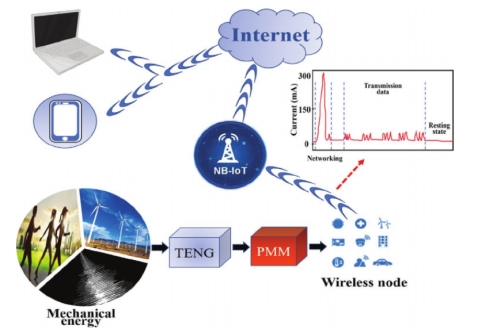Recently, the research group of Prof. Haiwu ZHENG from School of Physics and Electronics has made new progress in the power management strategy of friction nanogenerators. The related paper entitled A universal power management strategy based on novel sound-driven triboelectric nanogenerator and its fully self-powered wireless system applications has been published in the journal of Advanced Functional Materials (DOI:10.1002/adfm.202103081). Zhixin WANG and Yonghui WU are joint first authors. Prof. Haiwu ZHENG and Prof. Zifa WANG of Henan University and Academician Zhonglin WANG of Beijing Institute of Nano Energy and Systems of Chinese Academy of Sciences are the co-corresponding authors of the paper.

Fig.1 Schematic illustration of the system that integrates environmental mechanical energy harvesting, power management model (PMM), and the intelligent temperature and humidity recorder based on NB-IoT technology, and transmit data to the user interface through a wide area network to track environmental information in real time.
With the development of the Internet of Things (IoT), the power supply to trillions of IoT nodes has become a serious challenge. It is of significant importance to propose a rational power management scheme for constructing fully self-powered systems using triboelectric nanogenerators (TENG). In this study, as inspired by an embroidery hoop, a new type of TENG without the Helmholtz resonant cavity is developed for collecting sound energy, which can generate the Voc and Isc up to 500 V and 124 µA, respectively at a resonance frequency of 170 Hz and sound pressure of 110 dB. Furthermore, the sound-driven TENG integrated with a specially designed power management circuit derived from the universal power management strategy (PMS) can successfully drive a commercial narrow band-IoT wireless node, which realizes periodic temperature and humidity data acquisition and transmission. With the same strategy, an electric switch and a temperature and humidity acquisition system based on Bluetooth technology can also be powered by a contact-separated TENG and a wind-driven TENG, demonstrating excellent versatility, adaptability, and universality of the PMS. This study provides a novel solution for the application of TENG in the field of low-frequency IoT in local and wide areas.
The research work is supported by the National Key Research and Development Program of China, the National Natural Science Foundation of China, the Outstanding Youth Foundation of Henan Province, the Scientific and Technological Key Project of Henan Province and the Innovation Team of Universities of Henan Province.
Advanced Functional Materials is a well-known journal in the field of materials. The latest published impact factor of the journal is 16.83.
The link to the paper is https://onlinelibrary.wiley.com/doi/10.1002/adfm.202103081.
 Research /
Content
Research /
Content
 Research /
Content
Research /
Content


